I’m thinking about doing a report comparing several 100ish mm macro lenses, and I need a protocol to do modulation transfer function (MTF) and longitudinal chromatic aberration (LoCA) testing. I find it much more fun to devise new protocols than perform the old ones, so I jumped at the chance.
I can’t use any of my printed targets for this kind of testing, because I can’t print the edges sharply enough. I’d read that a razor blade is the gold standard for a slanted edge, so I came up with the following precision razor blade mount:
The blade is stuck into an AF tuning tool, which is mounted to a tripod with a gear head that I can use for alignment. Behind the razor blade is a white piece of paper illuminated by two Westcott 5000K LED panels. When you turn the room lights off and the panels on, here’s what you see:
For on-axis pictures, you put the blade edge in the center of the image:
After that, it was just a matter of modifying my old motorized-rail protocol. Here’s the first experiment I tried:
- Sony a7RII
- ISO 100
- Manual exposure
- Manual focus, set at one position
- Sony 90mm f/2.8 G Macro lens
- Cognisys computer-driven focusing rail
- 130 exposures 250 um apart
- Lens distance set at 1:2 magnification mark
- Document mode decoding with DCRAW
- MTF50s for all the raw color planes plus withe balanced calculated using MTF Mapper
- Graphing in Excel
Here’s a plot at f/2.8:
Distance is the horizontal axis, with the left hand size having the subject farther from the camera than the right hand side (The camera moves closer to the subject by 250 um after each exposure).
The first thing I noticed was that it looks like I missed the peak of all three raw planes because the steps were too big. Imagine that! 250 um steps are too big! Next time I’ll use 100 um or maybe even 50 um. I may have to make more exposures to make sure I get the peaks in the middle.
The next thing was the absolute value of the green and blue peaks. They are quite high for this lens, considering that we’re looking at raw channels with absolutely no sharpening and we probably missed the actual peaks. It looks like a razor blade may be a better slanted edge target than my printed ones, even at much longer subject distances.
The third thing of note was the LoCA, with the red channel achieving best focus with the camera farther away than the best-focus distance for the other two channels. The difference is about 500 um; I’ll be able to measure it more accurately when I redo the test with smaller steps.
At f/4:
Same idea, but the lens is getting sharper. I probably missed the peak in the red and blue channels.
F/5.6:
Not quite as sharp, and the LoCA is about the same.
F/8:
Sharpness is coming down, but the lens is still quite sharp.
F/11:
Now we’re really losing sharpness. The LoCA hasn’t actually gotten better, but you won’t see it in real images because it will be masked by the depth of field.
If we plot the white balanced MTF50 curves on one graph, we can check for focus shift:
There is some, but it’s not bad. I’ll check again with smaller steps.
I think this protocol will work fine.
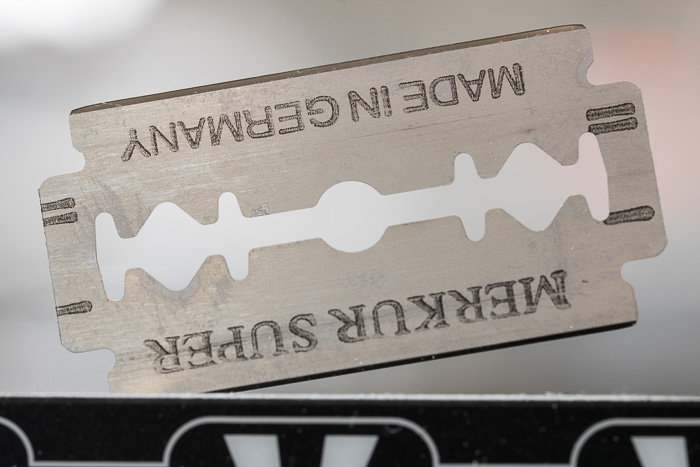
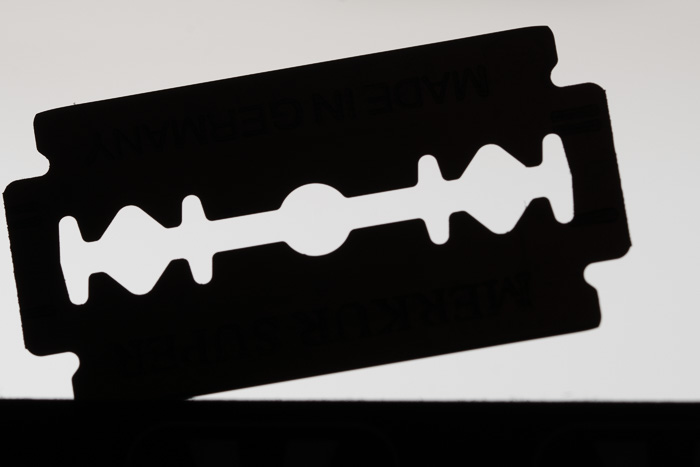
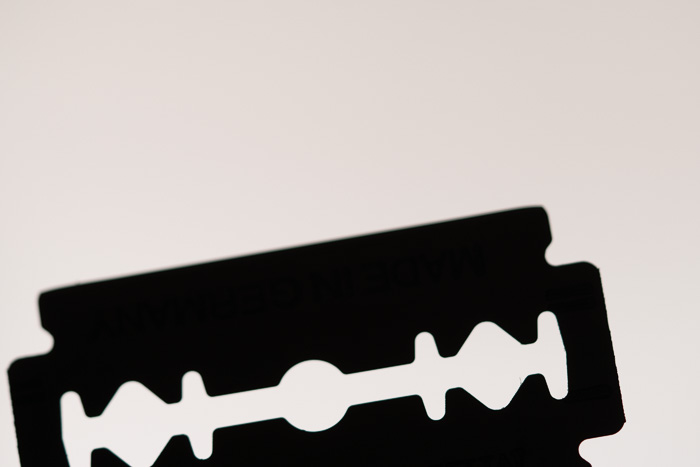

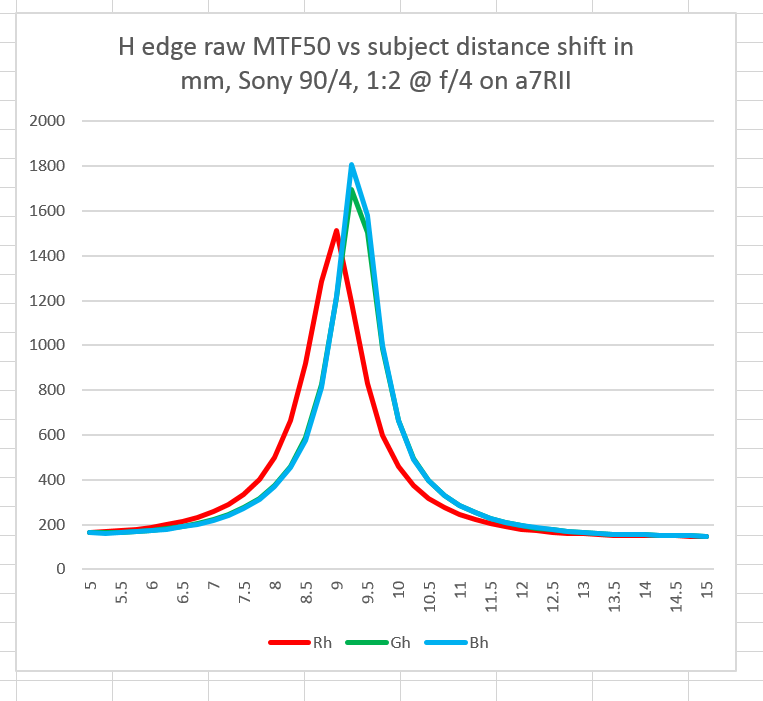

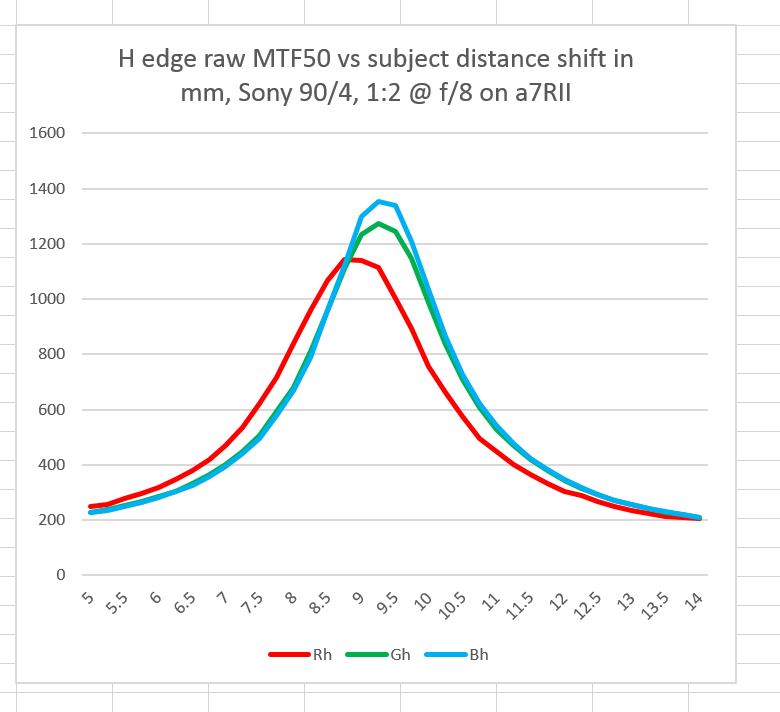
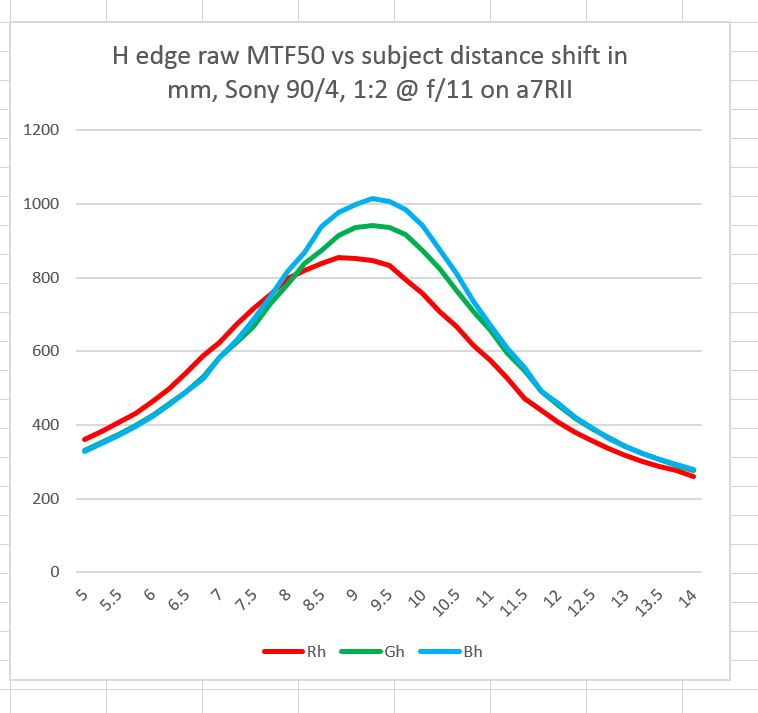
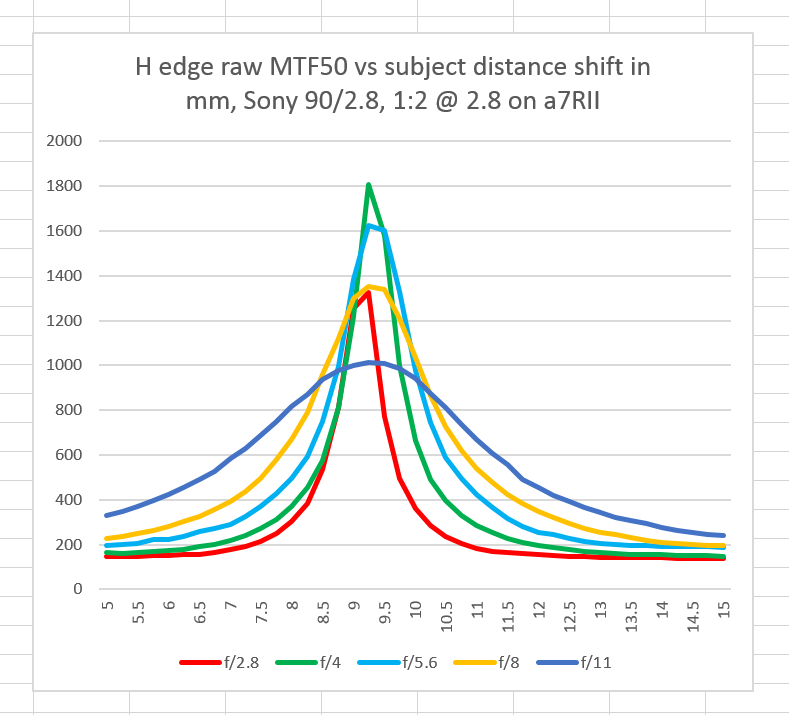
Does Sony compensate for the actual exit pupil based f-number like Nikon does? That’ll affect comparisons of macro lenses.
Also, regarding the loss in MTF at narrow apertures that you show here: I made a discovery that part of the loss of contrast at small apertures is actually caused by reflections off the edge of the diaphragm blade, in addition to diffraction. Simply looking at the exit pupil of a lens from the side with a light shining through shows the edge of the aperture reflecting light. As the aperture gets physically smaller, the perimeter increases relative to the area and so the reflections contribute more of the illumination relative to the image forming light.
This is what makes lenses with odd blade counts have alternating length diffraction star points: the one on the side of the blade in question is shorter and due purely to diffraction, while the one on the opposite side is brighter and longer, due to diffraction and reflection.
Any chance you could somehow measure this? Compare extreme stopped down performance loss between lenses, and correlate that with sunstar asymmetry? It might depend on how the diaphragm is constructed; perhaps consumer lenses with thicker plastic diaphragm blades might suffer more contrast loss than an extremely fine metal diaphragm because of a larger reflective area.
It might be good to look at MTF at a given frequency rather than MTF50 for that.
That’s an excellent point, and might go a long way to explaining why lenses start to look worse than you’d expect as you stop them down if all the loss were from diffraction.
Jim
Excellent Jim. Two things:
1) When a razor blade is used I have often seen it first blackened by candle smoke or other mean
2) It would be interesting to find out how much of the improved sharpness is due to the sharper edge and how much simply because this lens is fine tuned for close subjects.
Jack
Yes, I’ve seen that as well. But it didn’t look like it needed it for contrast, and I was afraid the bits of carbon would roughen the edge.
I know of no way to test that.
Jim
How about taking captures of the blade from (much) further away? Far enough to make the point but not so far that the edge will be too short for a reliable reading.
Worth a try. The blade is going to be much smaller than my usual target at my usual distances.
Several 100-ish macro lenses! Wow, that’s a lot of testing ;-}
Hope you are getting towards full recovery, btw…
Eats, shoots, and leaves.
You can try vwdof (http://toothwalker.org/optics/vwdof.html) to calculate the expected DOF. Scaling the DOF at 0.5x magnification versus whatever magnification you normally use (in your other tests) will give you a reasonable estimate of the expected focus step size.
Hi Jim,
you really made me curious about these focal shifts. I have started to do razor blade tests with an Otus 55mm that I have on visit. I work at 1:12.5 to have reasonable DoF for my simple nodal rail. I would like to know the options you use for
Document mode decoding with DCRAW
and the options for mtf_mapper as well, for the two cases
raw color planes
white balanced
Do you know Matlab? That would make the knowledge transfer easier. If not, I can pot something with a bit more work.
I am no Matlab user. Getting the calculation done is not the problem. Making sure the data is right at every stage of the process is an issue.. That is why I am interested to learn the right options to use for dcraw and for mtf_mapper
Thank you for sharing this.
When you opened your image in MTF Mapper, did you select the edge manually or opened it as a single edge image as something else? I am trying to test my camera using the razor blade method.
Thanks,
Aleks
The edge was selected by the Matlab program I wrote, based upon a crop selection dialog. It looks to MTF mapper like manual selection.